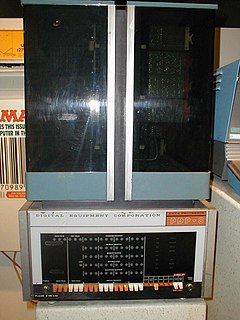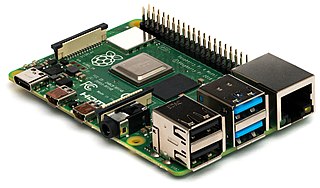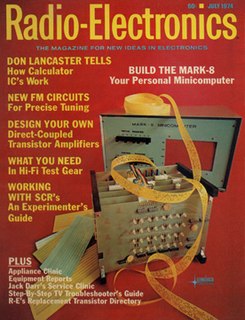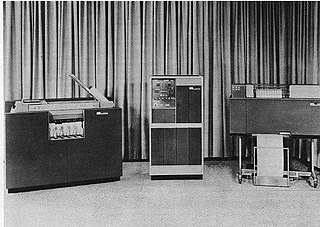For an overview of microcomputers of different kinds, see the following lists of microcomputers:
For an overview of microcomputers of different kinds, see the following lists of microcomputers:

BASIC is a family of general-purpose, high-level programming languages whose design philosophy emphasizes ease of use. The original version was designed by John G. Kemeny and Thomas E. Kurtz and released at Dartmouth College in 1964. They wanted to enable students in fields other than science and mathematics to use computers. At the time, nearly all use of computers required writing custom software, which was something only scientists and mathematicians tended to learn.
A disk operating system is a computer operating system that resides on and can use a disk storage device, such as a floppy disk, hard disk drive, or optical disc. A disk operating system must provide a file system for organizing, reading, and writing files on the storage disk. Strictly speaking, this definition does not apply to current generations of operating systems, such as versions of Microsoft Windows in use, and is more appropriately used only for older generations of operating systems.

A minicomputer, or colloquially mini, is a class of smaller computers that was developed in the mid-1960s and sold for much less than mainframe and mid-size computers from IBM and its direct competitors. In a 1970 survey, The New York Times suggested a consensus definition of a minicomputer as a machine costing less than US$25,000, with an input-output device such as a teleprinter and at least four thousand words of memory, that is capable of running programs in a higher level language, such as Fortran or BASIC.

A microcomputer is a small, relatively inexpensive computer with a microprocessor as its central processing unit (CPU). It includes a microprocessor, memory and minimal input/output (I/O) circuitry mounted on a single printed circuit board (PCB). Microcomputers became popular in the 1970s and 1980s with the advent of increasingly powerful microprocessors. The predecessors to these computers, mainframes and minicomputers, were comparatively much larger and more expensive. Many microcomputers are also personal computers.

ASCII (アスキー) was a monthly released microcomputer magazine in Japan, published by ASCII Corporation from 1977. It targeted business users who used a personal computer in their home and office, but it sometimes introduced computer games and computer music. It was also known as the Monthly ASCII (月刊アスキー) written along with the title from Vol. 2 No. 4, and distinguish with the Weekly ASCII (週刊アスキー) founded in 1997. The ASCII was rebranded as the Business ASCII (ビジネスアスキー) in 2008, and ceased in 2010. Its news website and the Weekly ASCII are continuing as in 2016.

The Mark-8 is a microcomputer design from 1974, based on the Intel 8008 CPU. The Mark-8 was designed by Jonathan Titus, a Virginia Tech graduate student in Chemistry. After building the machine, Titus decided to share its design with the community and reached out to Radio-Electronics and Popular Electronics. He was turned down by Popular Electronics, but Radio-Electronics was interested and announced the Mark-8 as a 'loose kit' in the July 1974 issue of Radio-Electronics magazine.

The PC-8800 series, commonly shortened to PC-88, are a brand of Zilog Z80-based 8-bit home computers released by Nippon Electric Company (NEC) in 1981 and primarily sold in Japan.

Your Computer was a British computer magazine published monthly from 1981 to 1988, and aimed at the burgeoning home computer market. At one stage it was, in its own words, "Britain's biggest selling home computer magazine". It offered support across a wide range of computer formats, and included news, type-in programs, and reviews of both software and hardware. Hardware reviews were notable for including coverage of the large number of home microcomputers released during the early 1980s.

The Socialist Federal Republic of Yugoslavia (SFRY) was a socialist country that existed in the second half of the 20th century. Being socialist meant that strict technology import rules and regulations shaped the development of computer history in the country, unlike in the Western world. However, since it was a non-aligned country, it had no ties to the Soviet Bloc either. One of the major ideas contributing to the development of any technology in SFRY was the apparent need to be independent of foreign suppliers for spare parts, fueling domestic computer development.
World Computer Speed Chess Championship is an annual event organized by the International Computer Games Association where computer chess engines compete against each other at blitz chess time controls. It is held in conjunction with the World Computer Chess Championship. Up to 2001, it was held in conjunction with the World Microcomputer Chess Championships and restricted to microcomputers.
HDOS is an early microcomputer operating system, originally written for the Heathkit H8 computer system and later also available for the Heathkit H89 and Zenith Z-89 computers. The author was Heath Company employee Gordon Letwin, who later was an early employee of Microsoft and lead architect of OS/2.

Commodore Power/Play was one of a pair of computer magazines published by Commodore Business Machines in the United States in support of their 8-bit home computer lines of the 1980s. The other was called Commodore Interface, changed to just Commodore in 1981, Commodore Microcomputer in 1983, and finally to Commodore Microcomputers in 1984 and for the rest of its run. The two magazines were published on an alternating, bimonthly schedule.
The history of the personal computer as a mass-market consumer electronic device began with the microcomputer revolution of the 1970s. A personal computer is one intended for interactive individual use, as opposed to a mainframe computer where the end user's requests are filtered through operating staff, or a time-sharing system in which one large processor is shared by many individuals. After the development of the microprocessor, individual personal computers were low enough in cost that they eventually became affordable consumer goods. Early personal computers – generally called microcomputers – were sold often in electronic kit form and in limited numbers, and were of interest mostly to hobbyists and technicians.

The British Broadcasting Corporation Microcomputer System, or BBC Micro, is a series of microcomputers and associated peripherals designed and built by the Acorn Computer company in the 1980s for the BBC Computer Literacy Project, operated by the British Broadcasting Corporation. Designed with an emphasis on education, it was notable for its ruggedness, expandability, and the quality of its operating system. An accompanying 1982 television series, The Computer Programme, featuring Chris Serle learning to use the machine, was broadcast on BBC2.

Acornsoft LISP is a dialect and commercial implementation of the Lisp programming language, released in the early 1980s for the 8-bit Acorn Atom, BBC Micro and Acorn Electron computers.

Lists of computers cover computers, or programmable machines, by period, type, vendor and region.

The Intellec computers were a series of early microcomputers Intel produced in the 1970s as a development platform for their processors. The Intellec computers were among the first microcomputers ever sold, predating the Altair 8800 by at least two years.